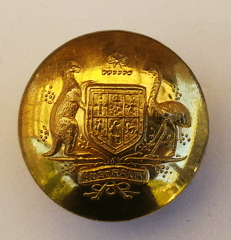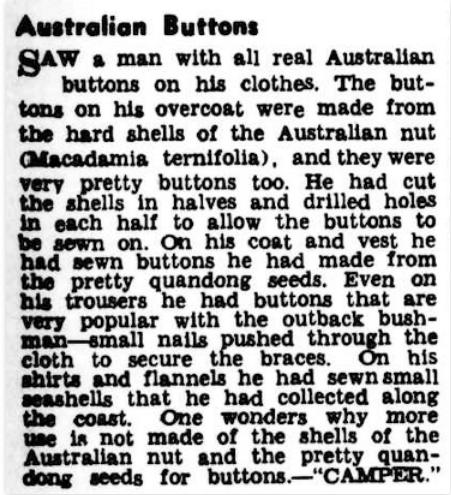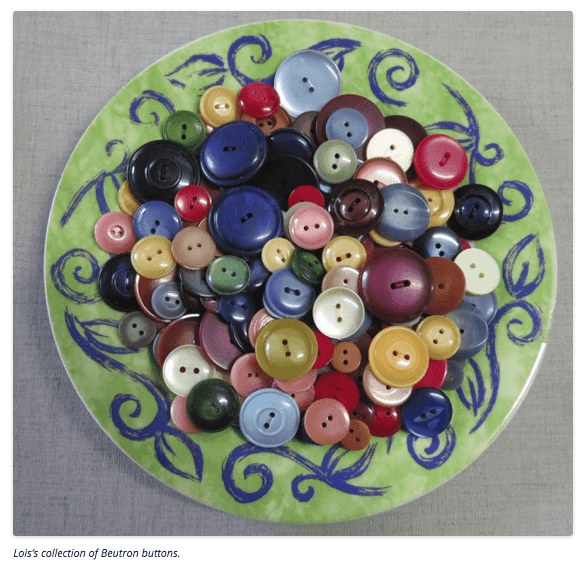“It is in the small things that are lost or misplaced that the details of everyday life may be found.”
Jennnie Lindenburg, ‘Buttoning Down Archaeology” from Australian Historical Archaeology 1999.
The following information was uncovered in large part in Trove, the free online service of the National Library of Australia. I thoroughly recommend it as a great resource. It contains scans of many historical newspapers,magazines, etc, and more is being uploaded all the time. Check out https://trove.nla.gov.au

The National Coat of Arms on a uniform button of staff of the Government House, Hobart. Made by Stokes and Sons.

The Queenslander, 5th August 1937 page 2.
Note: The subject of military/livery/uniform buttons is a study in its own right. This is not meant to be an exhaustive look at this particular subject, rather just to highlight any with an Australian providence. Please refer to specialty books/websites/clubs for more information on this sub-topic. If you do Facebook (I don’t) there is an ‘Australian Military and Civilian Button Collectors’ group. https://www.facebook.com/groups/285530375268324/
I am on the committee of the “Victorian Button Collectors Club”. They can be contacted with all queries button related, Australian or otherwise! http://www.vicbuttonclub.com.au
IDENTIFYING YOUR BUTTONS:
When people show a button to a collector they invariably want to know “when, what, where”. When was it made? What is it made from and what was it used for? Where did it come from? Sometimes these questions are easy to answer, sometimes not! Collectors, books and websites may be consulted, but sometimes you just need to do a bit of detective work. If the buttons are on a card you can search online for the brand/company. Search in archives such as the National and State archives, State Libraries and websites such as Trove (or equivalents). You can also Google a description, e.g. ‘glass scotty dog shaped buttons’ and see what comes up. Images will come up on Ebay/Etsy/Pinterest, etc . that may look like your buttons.
Beware that sellers often claim that their buttons (and other vintage items) are 10-30 years older than they actually are! Funny how they don’t make the mistake in reverse, that is to say, quote that the item younger than it is. Prices on the cards can help. In Australia we changed to decimal currency on 14th February 1966. For a short while in 1966-7 both imperial and decimal prices appeared. So, a card priced, for example, 65 cents, can’t be from the 1930s! Sellers note this please!! Also many so called ‘Art Deco’ buttons are from the 1950s, not 1930s, and many ‘rare’ buttons aren’t.
If a button has a backmark this can help, although beware that backmarks could be used for many years. For Australian manufacturers, check out the pages where I have outlined their history. For overseas makers, try Googling. There are lists of American and British backmarks that can be very helpful.
If the button has a Royal cypher or crown that will let you know the correct era. I once tried to explain to an over-excited metal detectorist asking for $100 for his so-called “Rare Pre-Federation Queensland police uniform button” was not so, as it had a “Kings Crown” (1902-1952) not a “Queen Victoria Crown”(pre-1902). Not trying to get a bargain (as I didn’t need the button for my collection) I tried to explain it was not rare or valuable. Alas, someone had told him it was, and he didn’t believe me. Royal cyphers and crowns date buttons to a certain Monarch’s era.
For buttons with British backmarks see these webpages for help:
https://www.ukdfd.co.uk/pages/buttonsgtom.html
https://oldcopper.org/makers/button_makers.php
https://www.angelfire.com/wa/dianaspage/BritishButtonBackmarks.html
https://www.britishbuttonsociety.com/
CONTACTING ME: PLEASE USING THE CONTACT FORM. I WILL REPLY TO ALL GENUINE QUERIES!
Thank-you!

